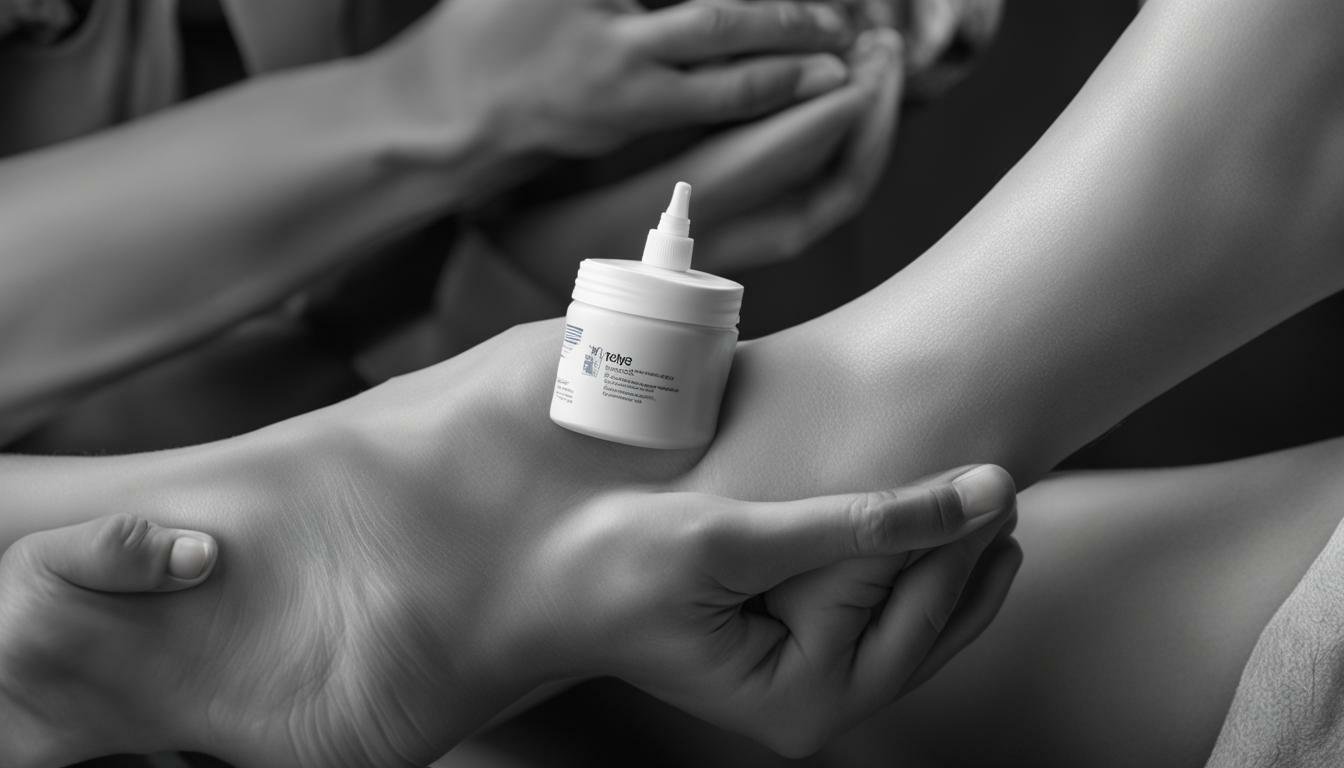Reduce Ankle Pain with Targeted Topical Analgesics
If you’re looking for fast and effective ankle pain relief, targeted topical analgesics are a great solution. The use of topical analgesics, such as the diclofenac epolamine topical patch (DETP), can effectively treat acute ankle pain caused by sprains and strains. Studies have shown that the DETP provides significant pain reduction compared to placebo, starting four hours after application. These topical NSAID patches deliver the medication directly to the pain site, minimizing systemic side effects. Other topical analgesics, including lidocaine and capsaicin, work by numbing the pain or depleting substance P from sensory neurons. It is important to use these products properly, following the instructions provided, and to consult a healthcare professional if pain persists or worsens.
Key Takeaways:
- Targeted topical analgesics, such as the diclofenac epolamine topical patch (DETP), provide fast and effective relief for ankle pain.
- DETP has been shown to significantly reduce ankle pain compared to a placebo, starting four hours after application.
- Topical NSAID patches deliver medication directly to the pain site, minimizing systemic side effects.
- Other topical analgesics, like lidocaine and capsaicin, work by numbing the pain or depleting substance P from sensory neurons.
- Proper usage and following instructions are important when using targeted topical analgesics. Consult a healthcare professional if pain persists or worsens.
Understanding Topical Analgesics for Ankle Pain Relief
Topical analgesics for ankle pain relief come in a variety of forms, such as ankle balms, rubs, and gels. These products are specifically designed to provide targeted relief by delivering medication directly to the affected area. Whether you’re dealing with acute ankle pain caused by sprains or strains, or chronic pain due to arthritis or overuse, topical analgesics can offer effective relief.
One popular option is the diclofenac epolamine topical patch (DETP), which has been proven to significantly reduce ankle pain. Studies have shown that the DETP provides greater pain reduction compared to a placebo, starting as early as four hours after application. This makes it a valuable tool in managing acute ankle pain.
In addition to the DETP, other topical analgesics like lidocaine and capsaicin can also provide relief. Lidocaine works by numbing the pain receptors in the affected area, while capsaicin depletes substance P from sensory neurons, reducing pain signals. These products offer different mechanisms of action, allowing individuals to choose the one that suits their needs best.
| Type of Topical Analgesic | Benefits |
|---|---|
| Ankle Balm | Easy to apply and provides targeted relief |
| Ankle Rub | Soothes the affected area and promotes circulation |
| Ankle Gel | Quickly absorbs into the skin for fast-acting relief |
To ensure the maximum effectiveness of these topical analgesics, it’s important to use them properly and follow the instructions provided. If the pain persists or worsens, it’s always a good idea to consult a healthcare professional for further evaluation. They can provide guidance on the best course of action for your specific situation.
The Power of Diclofenac Ankle Gel for Pain Relief
Diclofenac ankle gel has shown remarkable results in reducing ankle pain and can also be effective in alleviating knee pain caused by arthritis, overuse, or injuries when applied to the knees. This targeted topical analgesic contains diclofenac, a nonsteroidal anti-inflammatory drug (NSAID) that acts by reducing inflammation and relieving pain at the site of application. When massaged into the affected area, diclofenac ankle gel penetrates the skin, delivering the medication directly to the source of pain.
Studies have demonstrated the efficacy of diclofenac ankle gel in reducing acute ankle pain caused by sprains and strains. When compared to a placebo, the gel provided significant pain reduction, with effects observed as early as four hours after application. By targeting the pain directly, diclofenac ankle gel offers fast and effective relief without the systemic side effects commonly associated with oral NSAIDs.
In addition to its benefits for ankle pain, diclofenac ankle gel can also be beneficial for knee pain relief. When applied to the knees, it can help alleviate discomfort caused by arthritis, overuse, or injuries. The gel’s anti-inflammatory properties work to reduce swelling and relieve pain in the knee joints. It is important to note that the gel should always be used as directed and under the guidance of a healthcare professional.
| Ankle Pain Relief | Knee Pain Relief |
|---|---|
| Diclofenac ankle gel reduces inflammation and relieves pain at the site of application, providing effective relief for acute ankle pain caused by sprains and strains. | The gel can also be applied to the knees to alleviate knee pain caused by arthritis, overuse, or injuries. Its anti-inflammatory properties help reduce swelling and relieve discomfort. |
| The gel delivers the medication directly to the affected area, minimizing systemic side effects commonly associated with oral NSAIDs. | When used under the guidance of a healthcare professional, diclofenac ankle gel can provide targeted relief for knee pain without the need for oral medications. |
When using diclofenac ankle gel or any other topical analgesic, it is important to follow the provided instructions for proper usage. Consult a healthcare professional if the pain persists or worsens, as they can provide further guidance and recommendations for managing the pain. With its targeted approach and proven effectiveness, diclofenac ankle gel offers a valuable option for reducing ankle pain and providing relief for knee discomfort caused by arthritis, overuse, or injuries when massaged into the knees.
Studies on the Effectiveness of Topical Analgesics for Ankle Pain
Extensive research has demonstrated that topical analgesics, including DETP, NSAID patches, lidocaine, and capsaicin, have been clinically proven to provide significant ankle pain relief. These studies have shown promising results, offering an effective alternative to traditional oral pain medication. Let’s take a closer look at the evidence supporting the use of these topical analgesics for ankle pain relief.
In a randomized controlled trial, the diclofenac epolamine topical patch (DETP) was compared to a placebo for the treatment of acute ankle pain caused by sprains and strains. The study found that the DETP provided substantial pain reduction compared to the placebo, with a statistically significant difference seen as early as four hours after application. This highlights the rapid effectiveness of topical analgesics in managing ankle pain.
Furthermore, topical NSAID patches, such as those containing diclofenac or ketoprofen, have shown favorable results in reducing ankle pain. These patches deliver the medication directly to the pain site, minimizing systemic side effects often associated with oral NSAIDs. The localized application ensures targeted relief, allowing individuals to experience pain reduction without the potential risks associated with oral medication.
In addition to NSAID patches, other topical analgesics like lidocaine and capsaicin have also demonstrated their efficacy in alleviating ankle pain. Lidocaine, a local anesthetic, works by numbing the pain receptors in the area of application. Capsaicin, on the other hand, depletes substance P, a neurotransmitter involved in transmitting pain signals. Both of these mechanisms provide relief from ankle pain by interrupting the pain signaling process.
| Topical Analgesics | Ankle Pain Relief |
|---|---|
| Diclofenac Epolamine Topical Patch (DETP) | Significant pain reduction compared to placebo |
| NSAID patches (diclofenac, ketoprofen) | Localized pain relief without systemic side effects |
| Lidocaine | Temporary numbing of pain receptors |
| Capsaicin | Depletion of substance P, reducing pain signaling |
It is important to note that individual responses to topical analgesics may vary. Some individuals may find one type of topical analgesic more effective than others, depending on the nature and severity of their ankle pain. It is recommended to consult a healthcare professional to determine the most suitable option and to ensure proper usage of these products.
How Topical Analgesics Alleviate Ankle Pain
Topical analgesics work by either numbing the pain or depleting substance P from sensory neurons, providing targeted relief from ankle pain. These products, such as the diclofenac epolamine topical patch (DETP), are especially effective in treating acute ankle pain caused by sprains and strains. Studies have shown that the DETP delivers significant pain reduction compared to a placebo, with noticeable results starting just four hours after application.
The DETP is a topical NSAID patch that delivers medication directly to the pain site, minimizing systemic side effects. By targeting the affected area, the DETP provides fast and efficient pain relief without the need for oral medications. It works by inhibiting the production of prostaglandins, which are responsible for pain and inflammation. This targeted approach ensures that the medication is concentrated in the ankle, providing effective relief exactly where it’s needed.
In addition to the DETP, other topical analgesics like lidocaine and capsaicin are also used for ankle pain relief. Lidocaine works by blocking the transmission of nerve signals, effectively numbing the area and temporarily relieving pain. Capsaicin, on the other hand, depletes substance P from sensory neurons, interrupting the pain signals being sent to the brain. These mechanisms of action make topical analgesics a valuable tool in managing ankle pain, providing immediate relief without the systemic side effects associated with oral medications.
| Topical Analgesic | Mode of Action |
|---|---|
| Diclofenac Epolamine Topical Patch (DETP) | Inhibits prostaglandin production, providing targeted pain relief |
| Lidocaine | Blocks nerve signals, numbing the area and reducing pain |
| Capsaicin | Depletes substance P from sensory neurons, interrupting pain signals |
Studies have consistently shown that topical analgesics, like the DETP, are effective in reducing ankle pain. Their targeted approach and ability to provide fast relief make them a valuable treatment option for those suffering from acute ankle pain caused by sprains and strains.
When using topical analgesics, it is important to follow the instructions provided to ensure proper usage. Applying the product to clean, dry skin and gently massaging it into the affected area can enhance its effectiveness. However, if the pain persists or worsens, it is advisable to consult a healthcare professional for further evaluation and guidance. They can help determine the underlying cause of the pain and recommend appropriate treatment options.
Proper Usage and Considerations for Topical Analgesics
To ensure optimal results and safety, it is crucial to use topical analgesics properly, following the provided instructions, and seek medical advice if the pain persists or worsens.
Topical analgesics, such as the diclofenac epolamine topical patch (DETP), can offer effective relief for acute ankle pain resulting from sprains and strains. Studies have demonstrated that DETP provides significant pain reduction compared to placebo, with noticeable effects starting as soon as four hours after application. These patches deliver medication directly to the affected area, minimizing systemic side effects.
Lidocaine and capsaicin are other types of topical analgesics that work by either numbing the pain or depleting substance P from sensory neurons. Their use can provide immediate relief from ankle pain. However, it is important to use these products properly to ensure both effectiveness and safety.
Proper Application Techniques
When using topical analgesics, it is essential to follow the instructions provided. Clean the affected area before application and ensure it is dry. Apply the product generously, gently massaging it into the skin until fully absorbed.
Depending on the specific product, you may need to wait a certain amount of time before covering the area with clothing or bandages. It’s important to avoid applying heat or using heating pads immediately after application, as this can increase the risk of skin irritation or burns.
| Topical Analgesic | Application Technique |
|---|---|
| Diclofenac Epolamine Topical Patch (DETP) | Clean and dry the affected area. Apply the patch directly to the pain site. Wait at least 10 minutes before covering with clothing. |
| Lidocaine Gel | Clean and dry the affected area. Apply a thin layer of the gel and gently massage it into the skin until fully absorbed. Wait at least 5 minutes before covering with clothing. |
| Capsaicin Cream | Clean and dry the affected area. Apply a thin layer of the cream and gently massage it into the skin until fully absorbed. Wait at least 30 minutes before covering with clothing. |
It is worth noting that everyone’s pain experience and tolerance may vary. If the pain persists or worsens despite proper usage of topical analgesics, it is advisable to consult a healthcare professional. They can provide a comprehensive evaluation of your condition and recommend alternative treatment options if necessary.
Benefits of Targeted Topical Analgesics for Ankle Pain Relief
Targeted topical analgesics offer remarkable benefits for ankle pain relief, providing fast and effective relief by targeting the pain at its source. These specially formulated products work by delivering pain-relieving ingredients directly to the affected area, bypassing the need for oral medication.
One notable example is the diclofenac epolamine topical patch (DETP), which has been shown in studies to significantly reduce acute ankle pain caused by sprains and strains. Research has demonstrated that the DETP provides meaningful pain reduction starting four hours after application, making it a reliable choice for those seeking immediate relief.
Topical NSAID patches, like DETP, are designed to deliver the medication directly to the site of pain, minimizing systemic side effects that may occur with oral NSAIDs. This localized treatment approach allows for targeted pain relief, without affecting the entire body.
Additionally, other topical analgesics, such as lidocaine and capsaicin, can effectively alleviate ankle pain by numbing the pain or depleting substance P from sensory neurons. These ingredients work synergistically to provide both immediate and long-lasting relief.
| Benefits of Targeted Topical Analgesics for Ankle Pain Relief: |
|---|
| Fast and effective relief by directly targeting the pain at its source. |
| Localized treatment without systemic side effects. |
| Immediate relief through numbing the pain or depleting substance P from sensory neurons. |
| Long-lasting pain reduction. |
Conclusion:
When it comes to ankle pain relief, targeted topical analgesics offer a valuable solution. With their ability to provide fast and effective relief by directly targeting the pain at its source, these products are a reliable choice for those seeking immediate and long-lasting pain reduction. Whether you opt for the diclofenac epolamine topical patch (DETP) or other topical analgesics containing lidocaine or capsaicin, be sure to follow the instructions provided and consult a healthcare professional if the pain persists or worsens. Experience the benefits of targeted topical analgesics and reclaim your mobility without the discomfort of ankle pain.
Choosing the Right Topical Analgesic for Your Ankle Pain
Selecting the right topical analgesic for your ankle pain requires careful consideration of factors such as the intensity of the pain, personal preferences, and any underlying medical conditions. With a variety of options available in the market, it’s important to choose a product that suits your specific needs and provides effective relief. Here are some key factors to keep in mind when making your selection:
- Pain Intensity: Assess the severity of your ankle pain to determine the appropriate strength of topical analgesic. Mild pain may be relieved by over-the-counter balms or rubs, while moderate to severe pain may require prescription-strength gels.
- Active Ingredients: Different topical analgesics contain different active ingredients. Consider any allergies or sensitivities you may have and choose a product that is compatible with your skin.
- Application Method: Some topical analgesics come in balm or rub form, while others are in gel or patch form. Consider your preference for application methods and choose a product that aligns with your comfort level.
- Medical Conditions: If you have any underlying medical conditions, such as diabetes or cardiovascular problems, consult with a healthcare professional before selecting a topical analgesic to ensure it is safe for your specific health needs.
Remember to always follow the instructions provided with the topical analgesic and apply it as directed. If your ankle pain persists or worsens despite using a topical analgesic, it is important to consult a healthcare professional for further evaluation and treatment options.
| Product | Active Ingredient | Application Method | Strength |
|---|---|---|---|
| DETP | Diclofenac Epolamine | Topical Patch | Prescription Strength |
| Lidocaine Gel | Lidocaine | Gel | Over-the-Counter |
| Capsaicin Cream | Capsaicin | Cream | Over-the-Counter |
“Finding the right topical analgesic can make a significant difference in managing your ankle pain. By considering the factors mentioned above and selecting a product that suits your needs, you can find relief and get back to your active lifestyle.”
Conclusion
In conclusion, targeted topical analgesics are an excellent choice for reducing ankle pain, providing fast and effective relief that can greatly improve your quality of life. The use of topical analgesics, such as the diclofenac epolamine topical patch (DETP), has been proven to effectively treat acute ankle pain caused by sprains and strains. Studies have shown that the DETP provides significant pain reduction compared to placebo, starting four hours after application.
These topical NSAID patches deliver the medication directly to the pain site, minimizing systemic side effects. Additionally, other topical analgesics like lidocaine and capsaicin work by numbing the pain or depleting substance P from sensory neurons, providing immediate and long-lasting relief.
To experience the full benefits of targeted topical analgesics, it is important to use these products properly by following the instructions provided. It is also recommended to consult a healthcare professional if the pain persists or worsens. By doing so, you can ensure that you are using the right topical analgesic for your specific ankle pain and optimize its effectiveness.
By choosing targeted topical analgesics for ankle pain relief, you can enjoy the fast and effective relief they offer. Don’t let ankle pain hold you back – explore the wide range of topical analgesics available and take the first step towards a pain-free life.
FAQ
How do topical analgesics work to reduce ankle pain?
Topical analgesics work by delivering medication directly to the pain site, minimizing systemic side effects. They can either numb the pain or deplete substance P from sensory neurons, offering immediate and long-lasting relief.
What are some examples of topical analgesics used for ankle pain relief?
Some examples of topical analgesics used for ankle pain relief include diclofenac epolamine topical patch (DETP), lidocaine, and capsaicin. These products can be applied directly to the affected area for targeted pain relief.
Are topical analgesics effective in reducing ankle pain?
Yes, studies have shown that topical analgesics, such as DETP, can effectively reduce ankle pain compared to placebos. These products provide significant pain reduction starting four hours after application.
How should topical analgesics be used?
It is important to use topical analgesics properly by following the instructions provided. They should be applied directly to the affected area and massaged into the skin. If the pain persists or worsens, it is advisable to consult a healthcare professional.
What are the advantages of using targeted topical analgesics for ankle pain relief?
Targeted topical analgesics offer fast and effective relief by directly targeting the pain at its source. They minimize systemic side effects and can be used for both acute ankle pain caused by sprains and strains, as well as chronic pain caused by conditions like arthritis.
How do I choose the right topical analgesic for my ankle pain?
When choosing a topical analgesic for ankle pain, consider the severity of the pain, personal preferences, and any existing medical conditions. It may be helpful to consult a healthcare professional for guidance on selecting the most appropriate product.





